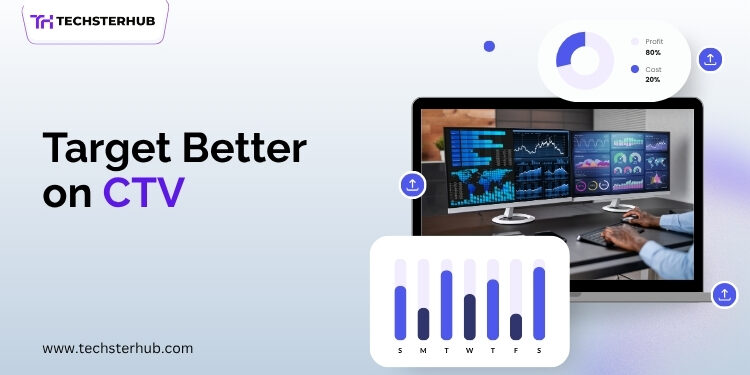Connected TV CTV advertising has become one of the powerhouse advertising channels as audiences continue to move away from traditional cable and toward streaming services. With platforms such as Hulu, YouTube TV, Netflix (with ads), Amazon Freevee and many others, having access to highly engaged viewers on the largest screen in the home is now directly at the brands’ fingertips.
However, there is no guarantee that CTV will actually work as well as it appears because this depends on how wisely data is applied. Data enables CTV to be a precision-driven performance channel – a place where advertisers can not only capture their ideal audience but try to measure and optimize campaigns with extraordinary accuracy.
This article provides a comprehensive, deeply strategic view of how to use data to drive stronger results, reduce wasted ad spend, and build a high-performing CTV advertising strategy that meaningfully impacts business growth.
Why Data is the Key to CTV Success
CTV combines two vital powers in a single product – prime TV attention and digital grade targeting. Historically television advertising had been limited to broad demographics. Today, CTV helps brands use the intelligence of behaviors and household to reach the most relevant viewers at the most relevant moment.
Data helps advertisers to understand:
- Who is watching
- What they are watching
- What they are interested in
- How they behave across devices
- Whether they take action after seeing an ad
This brings CTV from the area of mass exposure to the area of measurable outcomes. Every dollar spent is able to be linked to performance and attribution.
The Three Important Data Sources in CTV Advertising
A sophisticated CTV advertising strategy incorporates data from multiple inputs to form a more complete picture of the consumer.
First-Party Data
This is information that you collect yourself–in the form of your own business data that comes from your CRM, loyalty memberships, purchase history, subscriber lists, and website or app behavior, for example. As it is directly from actual customers, it is the most excellent foundation for targeting. It should be the first data source to be activated in CTV campaigns.
Second-Party Data
For these, the data are sourced from trusted partner platforms, including streaming publishers and media networks with retail media. Services like Roku and retail networks like Walmart Connect offer powerful signals to behaviors of viewing and buying activities. It broadens the knowledge and richness of contextualizing for targeting.
Third-Party Data
Aggregated audience segments from large data providers enable brands to scale reach based on detailed audience attributes such as: lifestyle interest, financial status, media habits and in-market intent. When combined with the first two sources of data, it reinforces the breadth of the campaign without hurting relevancy.
These three together ensure advertisers are not guessing—they are acting on verified audience intelligence.
Data-Driven Audience Targeting that Improves Relevance and Efficiency
The audience-targeting capabilities of CTV: this is what makes it most disruptive. Advertisers have the opportunity to target individuals on the level of their actual intent and household-level context – instead of broad proxies.
Well-structured CTV targeting takes into account factors such as:
- Behavioral signals, including browsing and app behavior
- Purchase intent and brand category interest
- Content viewing preferences such as genre or channel type
- Life stages such as new parents, home buyers, or college students
- Household attributes including income, location, and device usage
This helps make sure brands are seen by those that will have the highest chance of interest or conversion and will result in both increased media efficiency as well as decreased impressions lost on low value viewers.
The Value of Household and Point of Sale Data
CTV is delivered by IP connected home devices allowing for a unique advantage: household level intelligence. Brands can make sure that campaigns are associated with the real operations such as store servicing areas, dealership nearness, market competition, and region-specific demands.
For example:
- A retailer can advertise only to households near store locations.
- An auto dealer can reach viewers likely researching a new vehicle.
- A healthcare provider can target specific ZIP codes around its clinics.
Where traditional TV was broad, and generalized, CTV gives advertisers the ability to deliver accurate and accountable market-appropriate messages.
Data being the Driver of Creative Relevance
Targeting alone is not enough to assure performance. The messaging needs to be in line with the intent of the audience. Data helps to personalize at scale, through which brands can personalize creative assets in accordance to the needs of segments.
This includes:
- Tailored messages based on product or category interest
- Adaptation of ad variations for different geographies
- Sequential storytelling aligned with the customer journey
- A/B testing to identify the highest-converting elements
When creative speaks to the motivations and context of a viewer, it increases engagement and plays a larger role in the conversion results.
Measurement and Attribution: Bridging the CTV to Real Business Outcomes
One of the most important evolutions in CTV is the ability to track performance to precision. For example, advertisers are able to measure whether or not audiences who are exposed to a CTV campaign visit their website, interact with their app, contact their business or make a purchase.
Some Leone leading attribution methods at present are:
- Cross-device attribution that links CTV exposure to actions on phones or laptops
- Incrementality testing that proves the campaign’s true growth contribution
- Store visitation lift supported by verified location signals
- Conversion-level reporting such as form completes or transaction events
CTV has ceased to be restricted to awareness. It has become an important driving force in the bottom line. Matching CTV to performance KPIs can understandably justify marketers’ budgets.
Product Optimisation Using Constant Data Feeds
An effective CTV advertising strategy is never static. Real-time data can help advertisers to constantly fine-tune:
- Which platforms deliver the strongest response
- Which audiences demonstrate highest conversion value
- Optimal message sequencing and storytelling length
- Frequency levels to minimize overexposure and saturation
- Time-of-day or day-of-week pacing for viewer receptiveness
The more growth driven brands monitor the data closely and use the insights to improve efficiency one week after the other.
Industries Benefiting the Most in Terms of Performances
While almost all of the verticals now benefit from CTV, data-driven campaigns are yielding particularly big results in the following:
Retail and eCommerce, Automotive, Financial services, Healthcare and Clinics, Telecommunications providers, Higher education and online learning, Travel and Hospitality, Local and franchise-based service companies.
These including businesses rely on measurable behaviour towards conversion (pretty much what CTV is able to deliver when mere prosecuted by clever info).
Best Practices for a High-Performance CTV Advertising Strategy
Brands searching for maximum results should consider a strategic base including:
- Early and robust activation of first-party data
- Priority on high-quality, brand-safe media inventory
- Integrated campaigns that align CTV with search and social channels
- Clear performance benchmarks tied to business outcomes
- Transparent reporting and attribution from technology partners
The brands that are doing well in CTV are ones that consider it a core performance engine — not a test budget or experimental add-on.
Conclusion
Data is no longer optional in CTV Advertising. It is the main catalyst for audience precision, the creative relevancy, performance accountability, and continuous improvement. As streaming consumption continues to grow, CTV becomes increasingly center stage in terms of how brands influence the decision-making process and achieve conversion of consumer demand into tangible result.
A data-empowered CTV advertising strategy is the strongest path to driving revenue growth, eliminating wasted spend, and building a long-term competitive advantage in today’s media landscape.
CTV is the future of television advertising – and data is what is making it possible for that future to make a real impact.











